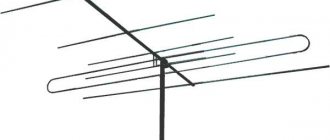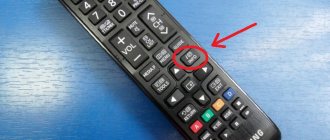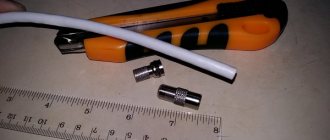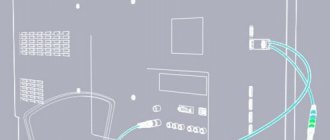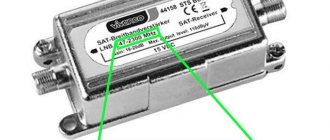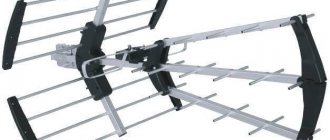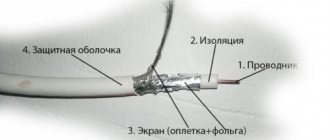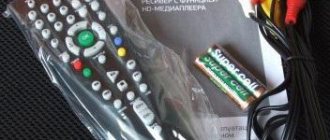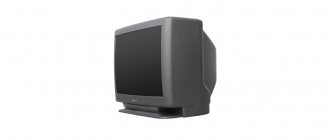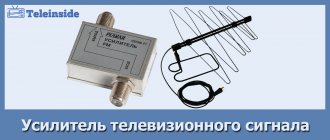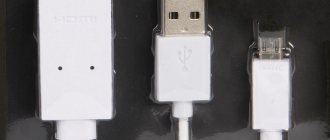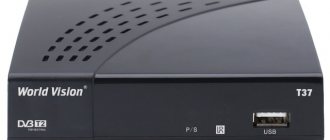In an area of uncertain reception of a television signal, in order to obtain a high-quality picture when watching television, you have to install an external antenna on the mast, on the vibrator of which an antenna amplifier is additionally installed. Installing an additional amplifier ensures a high-quality picture on the TV when the TV transmission tower is up to 100 km away.
Antenna amplifiers of the SWA line have become widespread due to their high reliability and low price. They are produced for different channel ranges and different gain factors, from 34 to 43 dB in the UHF range and from 10 to 15 dB in the meter range. The photo shows an amplifier type SWA-555/LUX.
The SWA television signal antenna amplifier must be powered with a constant voltage of 12 V. There is a circuit solution that allows supply voltage to the television amplifier via a coaxial cable simultaneously with the television signal. The photo shows how to connect a television wire to the SWA antenna amplifier.
The central core is clamped with one screw, and the shielding wire is stripped of insulation, wrapped and clamped with screws using a strip. The main thing here is to prevent the screen wires from shorting out with the central core. In this way, antenna amplifiers of any type installed directly on the antenna are connected.
There are special power supplies on sale - adapters with adapters that allow you to supply power to the antenna amplifier. The photo shows one of them. Connecting such an adapter is simple; the cable coming from the antenna is inserted into one coaxial wire, and the cable going to the TV is inserted into the second. The adapter itself is plugged into the socket. It is impossible to mix up the wires when connecting; the coaxial wires coming out of the adapter have different connectors, which prevents erroneous connections.
Power supply - adapter for antenna amplifier
If you open any power supply with an adapter, you will see a power transformer, four diodes, an electrolytic capacitor, a simple capacitor, a choke and a voltage stabilizer microcircuit.
All parts of the decoupling circuit, except the power transformer, are installed on the printed circuit board.
Electrical circuit diagram of the power supply for the antenna amplifier with adapter
The power supply shown above in the photo - an adapter for powering the antenna amplifier - is assembled according to a classic electrical circuit diagram. AC mains voltage 220 V is supplied to power transformer T1, which lowers it to 12-15 V. The diode bridge VD1-VD4 rectifies the voltage, the electrolytic capacitor C1 smoothes out the ripples, after which a constant voltage of about 16 V is supplied to the integrated voltage stabilizer DA1.
To eliminate video signal losses and loss of DC voltage, an LC filter is provided at the input of the television receiver, made on elements L1 and C3. Choke L1 does not pass a high-frequency television signal to the power supply circuit, but without losses it allows direct current to flow to the central core of the television cable coming from the television antenna amplifier. Capacitor C3 prevents DC current from flowing from the power supply to the TV input, but passes the TV signal without loss.
When making your own power supply with an adapter, parts can be used of any type. Typically, the current consumption of antenna amplifiers does not exceed 150 mA, which is less than 2 watts, so the transformer for the power supply is suitable for any power with an output voltage of 15-18 V. The choke can be made by winding it on a dielectric base, for example, a strip of fiberglass 5 mm wide, 25-18 V. 30 turns of enameled copper wire with a diameter of 0.1-0.5 mm.
Disadvantages of the presented design of the power supply with adapter
The disadvantages of a power supply adapter of this design include the presence of an unshielded section of the central core of the television cable at the place where it is sealed into the printed circuit board, which, in the presence of interference, for example from a working vacuum cleaner, can lead to interference with the video signal. The penetration of interference can be eliminated by installing an additional shield on the printed circuit board at the place where the wires are soldered.
see also
Comments 17
What I mean is that there are practically no “weak” tuners. If the tuner is t2, the antenna is on range, then it should not catch only 10 channels, it should catch everything. In general, at t2, it’s all or nothing. Ps The number of channels locally may vary by region.
I have come across such receivers and tested them on one antenna. I know because I sell these receivers. and the fact that 10 channels are picked up and 10 are not is due to the fact that somewhere nearby there is a tower with only the first working multiplex. and the signal from a distant tower where the set-top box does not pick up 20 channels, although if you connect another set-top box to the same antenna, it will receive 20 channels.
Everything is much simpler here. Today, digital broadcasting comes in two formats: dvb-t (the earliest standard, we have only 10 channels in it) and dvb-t2 (a newer standard, it has about 30 channels). Separate digital set-top boxes and digital tuners already built into TVs, respectively, can be either dvb-t2 or an earlier generation dvb-t. In the latter version, it will not show more than 10 channels and no antenna has anything to do with it. In general, we take new equipment from dvb-t2. If the TV has a built-in dvb-t tuner, you will have to buy a set-top box for more viewing.
Please read the article carefully again) my TV with dvb-t2 currently only has two multiplexes, i.e. 20 TV channels and 3 radio. Well, in Moscow and in large cities everything is much simpler, a home antenna or even a piece of wire is enough! I live about 70 km away from the tower.
Some tuners have a feature - active antenna feeding. You enable the option and you don’t need to do anything else)
yes, I know) in DVB-T2 digital set-top boxes, almost all have it, but unfortunately the TV itself doesn’t, that’s why I had to manage)
Hello. I bought a store-bought feeder via USB, but it still only shows 10 channels, and if you connect it the same way but through a set-top box, it picks up all 20, why is that so. TV POLAR.
Hello, I came across this, a weak built-in digital tuner. but before that you need to make sure that the “usb feeder” is working. Check the signal quality with and without power in the settings, or use a multimeter.
In the settings of the set-top box there is an item for antenna power, it is in the off position, but at the same time my antenna was fed via usb, 20 channels are received through the set-top box and when you pull out the usb, the broadcast stops, which means this feeder is working
This means that the tuner on the TV is weak, sometimes there were set-top boxes that showed only 10 channels instead of the possible 20. So either use the set-top box or use a different TV.
By the way, yes. I was wondering something, I’m thinking about how to supply 5V to the active antenna, which only receives power from the set-top box. Just install a block with a tip from a Polish antenna.
it turns out everything is simple)
Oh, what a great fellow you are! I went to Ali to look for such crap, but I myself have two of these plugs lying around from old Polish SWA amplifiers. And I’m generally silent about the presence of tails from USB. I didn’t realize that you could build it yourself in 5 minutes. Respect and respect!
In an area of uncertain reception of a television signal, in order to obtain a high-quality picture when watching television, you have to install an external antenna on the mast, on the vibrator of which an antenna amplifier is additionally installed. Installing an additional amplifier ensures a high-quality picture on the TV when the TV transmission tower is up to 100 km away.
Antenna amplifiers of the SWA line have become widespread due to their high reliability and low price. They are produced for different channel ranges and different gain factors, from 34 to 43 dB in the UHF range and from 10 to 15 dB in the meter range. The photo shows an amplifier type SWA-555/LUX.
The SWA television signal antenna amplifier must be powered with a constant voltage of 12 V. There is a circuit solution that allows supply voltage to the television amplifier via a coaxial cable simultaneously with the television signal. The photo shows how to connect a television wire to the SWA antenna amplifier.
Design and diagram of the crab
The TV crab is a metal box with F-connectors. Inside, on the central terminals of the connectors, parts (high-frequency transformers) of the television signal splitter are soldered. A high-frequency transformer is shaped like a ring or tube made of ferrite with a magnetic permeability of 600-2000, on which 1 to 10 turns of enameled wire with a diameter of 0.2-0.3 mm are wound, evenly spaced around the entire circumference.
In the photograph of the crab from which the back cover has been removed, you can clearly see how the ferrite transformers are wired for connecting three TVs. This crab is assembled according to the Electrical Circuit Diagram below.
All produced crabs are assembled according to the given electrical circuit diagram; there may be minor deviations - additional separating and filtering capacitors, chokes, and matching resistors are installed.
How to make your own adapter for supplying power to an antenna amplifier
When making an adapter for supplying power to an isolated antenna amplifier, I decided not to install an additional connector for connecting the power supply, but to use one of the connectors for connecting the F-plug. To do this, we had to remove one of the transformers, limiting the crab's ability to connect only two TVs.
As a result of the modification, only two TVs can be connected to the crab, and its circuitry has changed.
All that remains is to install the LC filter in the crab and the adapter will be ready for use. Since the crab body is made of duralumin, the capacitor lead had to be connected to it through an additionally installed brass terminal, screwed to the adapter body using a screw and nut with a shaped washer.
As a result of the modification, the electrical circuit diagram of the crab acquired the following form. As can be seen from the diagram, transformer T1 remained original, but a choke and two capacitors were added.
To better match the circuit, you can solder a 150 Ohm resistor between the output pins XW2 and XW3. You can install the adapter in any convenient place, directly next to one of the TVs, or, for example, at the cable entrance to the apartment. If you need to connect only one TV, then transformer T1 can be removed, and the right terminal of capacitor C1 can be soldered directly to the central terminal of one of the connectors XW2 or XW3, to which the cable going to the TV can be connected.
see also
Comments 17
What I mean is that there are practically no “weak” tuners. If the tuner is t2, the antenna is on range, then it should not catch only 10 channels, it should catch everything. In general, at t2, it’s all or nothing. Ps The number of channels locally may vary by region.
I have come across such receivers and tested them on one antenna. I know because I sell these receivers. and the fact that 10 channels are picked up and 10 are not is due to the fact that somewhere nearby there is a tower with only the first working multiplex. and the signal from a distant tower where the set-top box does not pick up 20 channels, although if you connect another set-top box to the same antenna, it will receive 20 channels.
Everything is much simpler here. Today, digital broadcasting comes in two formats: dvb-t (the earliest standard, we have only 10 channels in it) and dvb-t2 (a newer standard, it has about 30 channels). Separate digital set-top boxes and digital tuners already built into TVs, respectively, can be either dvb-t2 or an earlier generation dvb-t. In the latter version, it will not show more than 10 channels and no antenna has anything to do with it. In general, we take new equipment from dvb-t2. If the TV has a built-in dvb-t tuner, you will have to buy a set-top box for more viewing.
Please read the article carefully again) my TV with dvb-t2 currently only has two multiplexes, i.e. 20 TV channels and 3 radio. Well, in Moscow and in large cities everything is much simpler, a home antenna or even a piece of wire is enough! I live about 70 km away from the tower.
Some tuners have a feature - active antenna feeding. You enable the option and you don’t need to do anything else)
yes, I know) in DVB-T2 digital set-top boxes, almost all have it, but unfortunately the TV itself doesn’t, that’s why I had to manage)
Hello. I bought a store-bought feeder via USB, but it still only shows 10 channels, and if you connect it the same way but through a set-top box, it picks up all 20, why is that so. TV POLAR.
Hello, I came across this, a weak built-in digital tuner. but before that you need to make sure that the “usb feeder” is working. Check the signal quality with and without power in the settings, or use a multimeter.
In the settings of the set-top box there is an item for antenna power, it is in the off position, but at the same time my antenna was fed via usb, 20 channels are received through the set-top box and when you pull out the usb, the broadcast stops, which means this feeder is working
This means that the tuner on the TV is weak, sometimes there were set-top boxes that showed only 10 channels instead of the possible 20. So either use the set-top box or use a different TV.
By the way, yes. I was wondering something, I’m thinking about how to supply 5V to the active antenna, which only receives power from the set-top box. Just install a block with a tip from a Polish antenna.
it turns out everything is simple)
Oh, what a great fellow you are! I went to Ali to look for such crap, but I myself have two of these plugs lying around from old Polish SWA amplifiers. And I’m generally silent about the presence of tails from USB. I didn’t realize that you could build it yourself in 5 minutes. Respect and respect!
I have a Sony TV at home that supports DVB-T2. This means that you can watch 20 channels in good quality for free. I live in a village and in a hole, so I chose an active antenna of this type (I didn’t even consider the Polish “lattice” antenna) Outdoor active antenna Locus Efir-08AF
Connecting the power supply to the adapter
Since I decided to connect the power supply to the crab through one of its F-connectors, to implement this idea I had to make an adapter from an ordinary double wire coming from the power supply to a coaxial cable.
To do this, you need to take a piece of antenna cable 5 cm long, cut one end of it and put on an F-wrap. To the second end, as shown in the photographs, solder the wires coming from the power supply with a shift. The positive terminal is soldered to the central core of the antenna cable.
If you don’t want to mess around, you can install a standard connector in the crab body for connecting power supplies and through it supply voltage to the antenna amplifier through a home-made adapter.
